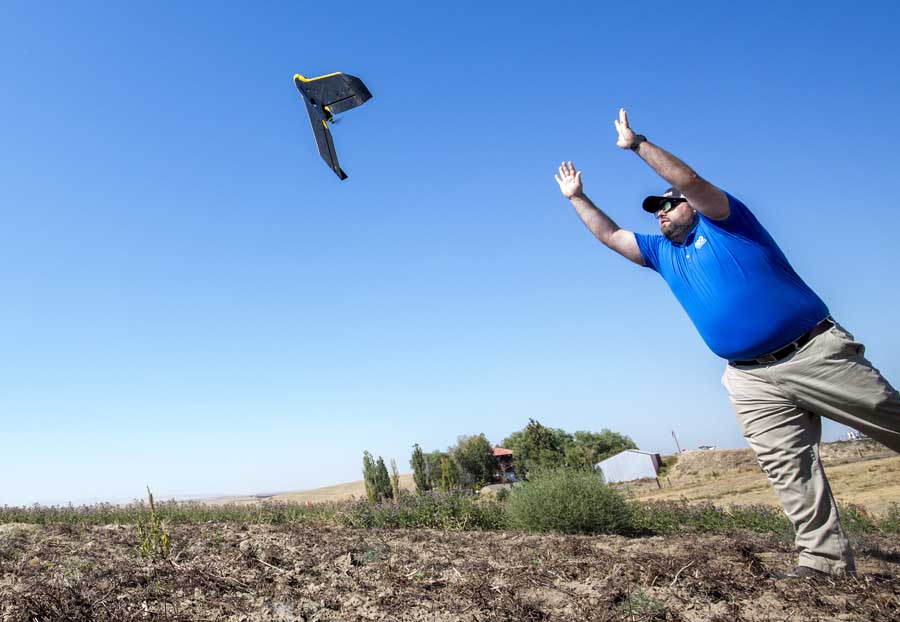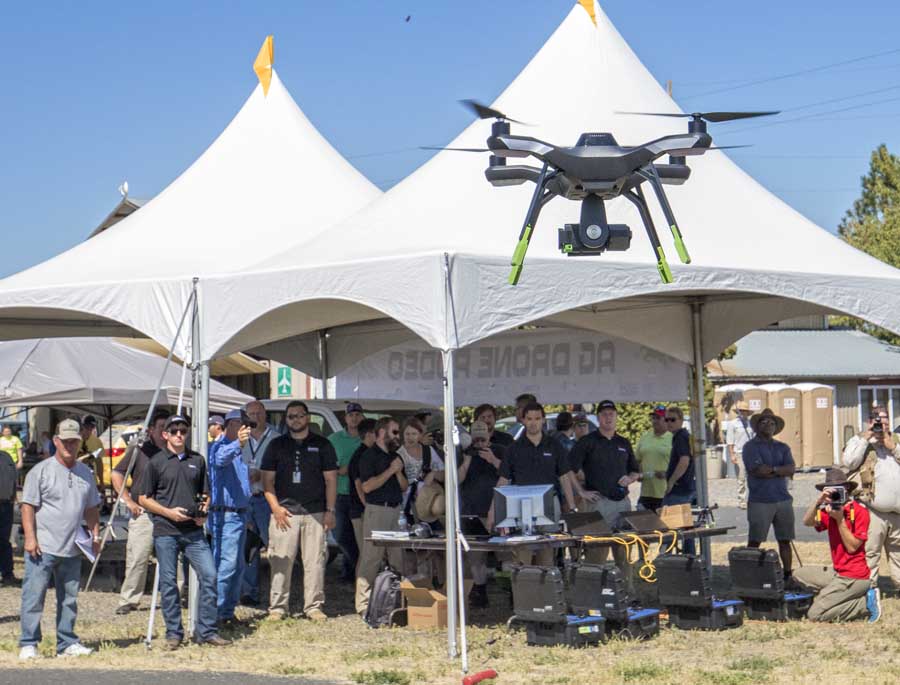Listening to drone manufacturers, researchers and enthusiasts, you would think they are revolutionizing agriculture tomorrow.
“This is like Kittyhawk,” Jeff Lorton of Oregon UAS Future Farm announced to a giddy crowd watching demonstrations of unmanned aircraft at a recent conference he staged.
Sort of.

Gary Licquia launches a SenseFly eBee unmanned aerial vehicle, or drone, equipped with a multispectral agricultural sensor during the Ag Drone Rodeo in August in Pendleton, Oregon. Licquia works as a mapping product manager for RDO Integrated Controls, one of several groups demonstrating drones for agricultural use in a field adjoining Linn Airfield. (TJ Mullinax/Good Fruit Grower)
Listen closely. Those insiders still use phrases like “what if” or “envision” or “potential.”
In spite of rapid advancements, drones still aren’t quite there for widespread use in tree fruit and wine grapes.
They have shown promise with drying cherries and chasing away birds, for example. And in theory, researchers can now from the air detect the difference between healthy and not-so-healthy trees using drone imagery.
But sensors still have yet to accurately and consistently measure tree health over wide areas, anticipate yields or identify pest pressure, and they can’t make any diagnoses from above. Even ardent supporters admit they still have work to do when it comes to helping tree fruit.
“Apples are tricky — really, really tricky,” said John Sulik, applications specialist with MicaSense, a Seattle company that makes drone sensors and software for agricultural purposes.
An August event in Pendleton, Oregon, called the Ag Drone Rodeo, attracted 250 people to watch vendors demonstrate the flying of unmanned aerial vehicles, often called UAVs or drones.
The first day, at a test strip near the airport, focused on the flying, while the second day centered on how to make use of the flight data generated by a drone.
It was organized by Lorton, project manager for the Oregon UAS Future Farm, a real-world test range for drone and sensor manufacturers.

Jeff Lorton, the coordinator of the Ag Drone Rodeo, welcomes attendees to the event. (TJ Mullinax/Good Fruit Grower)
Most sensors attached to drones rely on light reflection — both visible and invisible, including near-infrared wavelengths — to create a map of a field or orchard.
Tree canopies with varying heights and shadows throw off those sensors. Also, Federal Aviation Administration regulations require a line of sight between drone and operator.
To comply, orchardists often need to stand on a lift, ladder or nearby hill. Then, for drones to be cost effective, growers would have to use them over a wide area.
“The problem we’re having: The battery life on those is so short we’re not able to make it through even a couple of vineyards,” said Jenn Smithyman, precision agriculture specialist for Ste. Michelle Wine Estates near Prosser, Washington.
The company, the third largest premium wine company in the U.S., uses a variety of imagery from manned flights over 8,000 acres every year.
She suspects smaller boutique growers may be using the drones, “mixing their recreational activities with their farming jobs,” she said. But she and others in the industry like the direction drone technology is headed.
“We’re still a few years out, but we’re almost there,” said Alex Ott, executive director of the California Apple Commission.
The Fresno-based group has sponsored several pending research projects into the use of drones in apples and blueberries, also represented by the commission. Among them: studies into mapping, detecting pest pressure and targeted spraying.
The current state of drones

A Yamaha RMax UAV flies a prearranged flight path to spray from two tanks filled with water over a field. The capacity of each tank is about 2 gallons. (TJ Mullinax/Good Fruit Grower)
Some growers use UAVs commercially now, though not extensively.
Washington growers have deployed drones to chase away birds, California wine grape growers have begun spraying with unmanned flights, and an Oregon viticulturist has used a drone to map future plantings and measure elevation for an irrigation project.
Earlier this summer, Yamaha Corp. agricultural vendors sprayed fungicide on wine grapes in California’s Sonoma and Napa counties with the RMax, an unmanned helicopter with a 10-foot rotor span, marking the first time a drone has been used for commercial spraying in the United States.
The work stemmed from three years of trials with the University of California-Davis.
The results were encouraging, Brad Anderson, manager for Yamaha’s U.S. unmanned systems division, said in a phone interview.
The company plans to expand next year after setting its price schedule. However, the unmanned flights can’t cover anywhere near the same amount of ground as a conventional crop duster.

A Yamaha RMax UAV takes off at the Ag Drone Rodeo. (TJ Mullinax/Good Fruit Grower)
“We are a much better platform for smaller fields, tight spacing, hillsides, things of that nature,” Anderson said.
The company has been using the unmanned helicopters to spray crops in Japan for 20 years and currently operates about 2,400 unmanned helicopters in that country. In the U.S., it has six.
Most other drone work is still in the research arena. In July, Washington State University researchers from the Center for Precision and Automated Agricultural Systems used an octocopter — an unmanned helicopter with eight rotors — to collect overhead images of a test block during an apple fire blight resistance trial at the Columbia View Orchard in Wenatchee. Researchers are still analyzing data from those trials.
Last year, the Yamaha RMax group worked with researchers at WSU’s center to dry cherries grown on modern architecture at Washington State University’s Irrigated Agriculture Research and Extension Center in Prosser.
It worked.
The unmanned helicopter removed water from cherry trees at a rate of 5.4 to 11 acres per hour depending on flying speed, more than the 3.7 acres per hour a grower would do with a tractor-pulled airblast sprayer, but much less than the 18.5 acres possible with a manned helicopter.
The experiment, published in April this year in the journal Computers and Electronics in Agriculture, used cherry trees after harvest and wetness sensors that mimicked leaves, an indirect indicator of the water that would be on cherries.
The group has applied for U.S. Department of Agriculture funding to repeat the test using a sensor that would measure cherry wetness in the stem bowl and tip more directly, said Lav Khot, an assistant professor for the center.
He also has used the drone to help collect data regarding vineyard canopy health and temperature for a subsurface irrigation trial in the fields near the Prosser facility. “For me, a drone is just a tractor,” he said.
The future

A spectator records the takeoff of Aerial Technology International’s AgBot during a presentation. The quadcopter demonstration highlighted ATI’s AgPlanner software to help growers plan consistent flight patterns for data recording over time. (TJ Mullinax/Good Fruit Grower)
To overcome shadows in tree canopies, Khot’s colleagues are toying with the idea of flying drones low, between rows, scanning horizontally to estimate yields or pre-identify fruit for an automated harvester.
Manoj Karkee, another researcher at the center, has filed an invention disclosure with the university’s commercialization office, a precursor to pursuing a patent.
“There is so much possible with UAVs,” Karkee said.
What about those pesky birds? He envisions tying remote sensors to a computer program that would detect birds and automatically deploy the drones to shoo them away. Same goes for elk and deer.
Meanwhile, better sensors are on the horizon, according to Young Kim, CEO of Digital Harvest, a Virginia precision agriculture company. At the Drone Rodeo, he compared the gap between current and future sensors to the difference between X-rays and MRIs.
“We’re sort of at the X-ray stage today,” he told the crowd.

Aerial Technology International’s AgBot is loaded with a multispectral sensor by MicaSense. (TJ Mullinax/Good Fruit Grower)
So far, the multispectral sensors used on drones can detect light reflection, but nothing that can be tied to a certain problem or disease.
A commonly used tool is the Normalized Difference Vegetation Index, which combines visible and near-infrared light readings to detect relative amounts of healthy vegetation.
Shadows, reflective ground cover, sunburn protectants, cover crops and even moisture on the leaves can throw off those measurements.
Kim envisions a possible switch from multispectral imaging to hyperspectral imaging, an ultra-high resolution technology that can identify unique electromagnetic “fingerprints” of different diseases or pests.
Oil companies use hyperspectral sensors to help spot underground reserves. However, hyperspectral imaging requires an enormous amount of processing capacity, which in turn would require upgrades in bandwidth and connectivity for drones and operating computers to handle.
For now, Kim and Digital Harvest have a partnership with Yamaha that allows them to operate in Washington and Oregon and eventually offer aerial monitoring and spraying services.
The company is pursuing permits from the FAA and pesticide applicators licenses from both states to make that a reality.
However, even if they had that paperwork in order today, “I wouldn’t go to the tree fruit industry right now,” he said in a follow-up interview with Good Fruit Grower.
Instead, he said he would stick with potatoes or another crop that would benefit from spot spraying.

One of three 3DR Solo drones lands in front of spectators. The 3DR drones, equipped with GoPro cameras, were flown together to show how multiple drones could be used together to quickly collect agricultural data from the air. (TJ Mullinax/Good Fruit Grower)
“As much as people are anxious to want something now,” the technology just isn’t quite there yet, he said. “We got a lot of learning to do.” •
– by Ross Courtney
Drone up
Interested in using a drone in your orchard now?
The Federal Aviation Administration recently made the permission process easier.In late August, the FAA opened up applications for a Part 107 waiver, which allows a broad range of commercial activity for operators of unmanned aerial vehicles under 55 pounds.
In the past, the FAA required anyone who wanted to use a drone commercially to apply for an exemption for a narrowly defined specific purpose and place — the “Section 333 Exemption,” in regulation parlance.That exemption is still required for aircraft above 55 pounds, which includes the Yamaha RMax, the only drone so far big enough to carry pesticides or dry off cherries with its downwash.
To find out more about Parts 107 and 333, visit this comparison sheet on the FAA website:
www.faa.gov/news/updates/?newsid=86285.






“In spite of rapid advancements, drones still aren’t quite there for widespread use in tree fruit and wine grapes.”
I do agree with that statement, but i personally think that, in future, the drone could be more sophisticated.It can find fruit and pick it up.A ripe fruit can be detected by the sensor, or maybe the people who control the drones, can actually pick the fruits and bring it to the table. That’s will reduce man power and cut the cost.